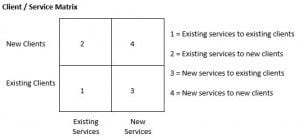What services do your clients buy from you?
Are they buying all of the services they could be?
Or are they buying some services from someone else that you (could and should) provide?
Have you ever thought about this?
In essence your share of wallet is the percentage of $ spent with you against the total $ spent on all the services you could provide.
In the big end of town the share of wallet is often managed by having panels of service providers, particularly for lawyers. The business may have very clear process for how they divide up the share of wallet for each panel member based on certain criteria. Most SME’s will not formally do this but perhaps they do shop around or worse still just don’t understand the full range of services you can provide them and go somewhere else assuming you can’t help.
My own business is a good example. In working with professional firms (mostly accountants) I provide coaching, consulting, training, mentoring and facilitation services across pretty much all aspects of the firm. I want to make sure that for my existing clients they have no need to go to other providers if, and this is key, I genuinely believe I am the best person to deliver those services.
I certainly don’t want a client to say “We got X to facilitate our planning days because you don’t do that” Oops, oops and oops! I say to the client “I love doing planning day facilitation and have done quite a few” So why didn’t the client ask? Is the relationship not such that they feel comfortable to check? And why had I not made that client aware of my full capability? (This has not happened to me, but it makes the point I hope!)
It is an important concept because of the conventional wisdom that it is easier to sell to existing clients than win new ones.
Consider the simple matrix below.
Clearly 1 should take the least effort. You already have a relationship with these clients and you are already providing these services to other clients.
2 and 3 may take different amounts of effort depending on the circumstances of your firm. If you have strong capability and capacity to win new clients but are weaker when it comes to developing new services, then 2 will be easier than 3. For some firms it will be the other way around.
What is clear, is that 4 is the one that is going to take the most effort.
Go for the low hanging fruit – 1 is the place to be! At least to start with.
There is another reason why making sure you have 1 covered is important. If another service provider “gets their foot in the door” they may try to takeover other services you are providing. Don’t let that happen! Get on the front foot with your clients.
So how do you do that?
I think there are two pretty straightforward things to start with:
- Track what services you provide to which clients
- Have a structured approach to educating your clients on your capabilities
To track services you could do a simple matrix that has clients listed down the page and services list across the page, like the example below
In this matrix the shading indicates that service is being provided to the client, N/A indicates that it genuinely not a service applicable to that client and the blanks indicate the huge opportunity available to you. Are you taking advantage of this opportunity?


